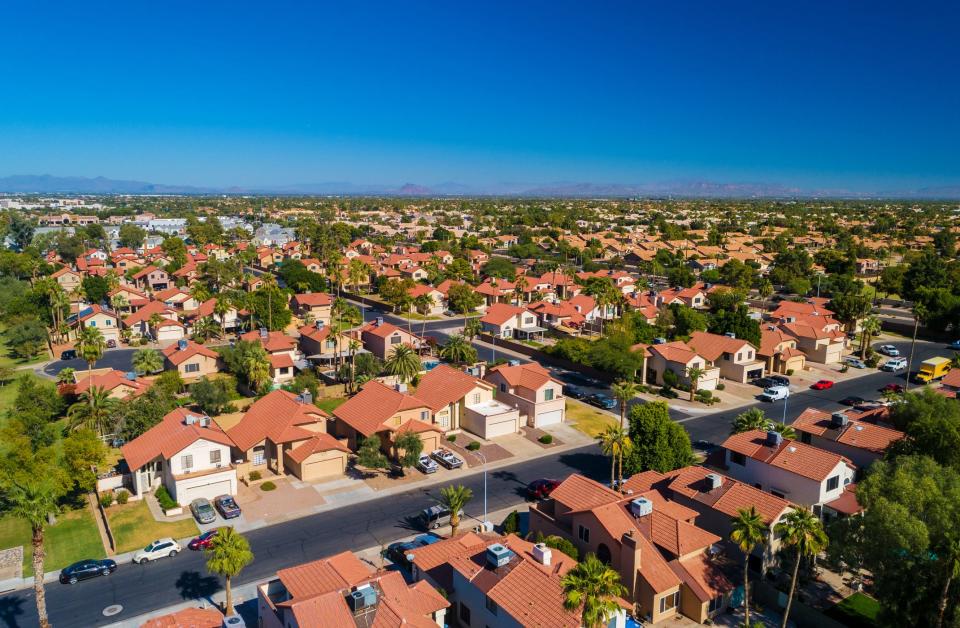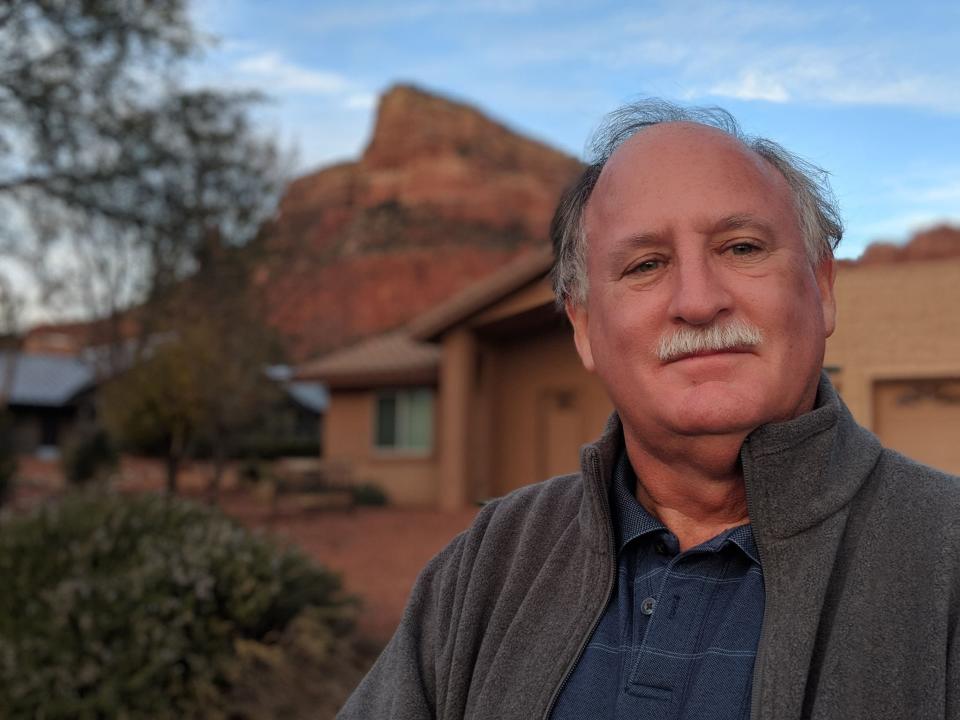Low wages, housing shortage puts financial burden on renters across Arizona
Low wages, a housing shortage and more short-term rentals and vacation homes are limiting access to affordable housing, according to a study of six Arizona counties by Arizona State University's Morrison Institute for Public Policy.
The study compiles research from Maricopa, Yuma, Cochise, Coconino, Yavapai and Pima counties, including discussions with residents.
Solutions lie in diversifying the housing stock, regulating short-term rentals and increasing rental assistance, according to Morrison Institute.
The institute found that across the state a common theme associated with housing insecurity is that low wages earned by many renters, especially people of color, limit their housing access.
For instance, according to the study, it would take a minimum wage earner in Coconino County's largest city, Flagstaff, a 90-hour work week to afford a one-bedroom apartment. The average renter wage in Coconino County is just over $18.
The burden of high rent makes it difficult for many renters to transition to homeownership.

People face a housing cost burden when they spend more than 30% of their household income on housing, including rental or mortgage costs. About one in three Arizona residents face this challenge, according to 2021 U.S. Census Bureau estimates.
Homeowners can be cost-burdened but renters are more susceptible to allocating more than 30% of their household income to housing, according to the study.
In each of the six counties, more than 40% of renters are cost-burdened. The housing cost-burden rate for homeowners ranges from 20% in Maricopa and Cochise counties to 26% in Yavapai County.
Intense competition for rentals in northern Arizona
Coconino County, the second largest county in the U.S. by land size, has the worst cost burden for renters of the six counties studied. Half of Coconino's renter households spend over 30% of their income on housing.
Renters — 39% of the county’s residents — have intense competition for few available housing units. For instance, one resident who participated in a focus group for the study told the institute that more than 30 other people applied for a unit they were interested in within hours of the listing being posted.
Residents also said that the availability of affordable housing declined as the number of short-term rentals increased in the county.
From 2016 to 2020, the number of whole-house Airbnb rentals in Coconino County grew by more than 500%, according to AirDNA data cited by the Morrison Institute. In 2016, there were 415 listings on Airbnb on average each month. By 2020, the number grew to more than 2,500.

The number of short-term rentals has also grown in recent years in Yavapai County, worsening the housing shortage in cities like Sedona, Verde Valley, Cottonwood and Camp Verde. AirDNA data shows there were 374 whole-house Airbnb rentals, per month on average, in Yavapai County in 2016. By 2020, that number had grown to 2,171.
A significant number of second homes also reduces the county’s available housing stock.
Of about 747,000 vacant homes in Arizona, about half are vacation homes. U.S. Census Bureau survey data shows that the share of second homes is much higher in some Arizona counties, including La Paz (75.2%), Coconino (73.3%), Yavapai (66.5%), Mohave (71.5%), Navajo (71.8%), Yuma (67.2%) and Pinal (61.3%).
Low wages drive housing insecurity
Wages have not kept pace with housing prices across all six counties Morrison Institute studied. Focus group participants said their jobs just don’t pay enough for them to be able to afford good housing near where they work.
For instance, only about 26% of people who work in Sedona actually live in the city, according to the study. According to recent U.S. Census Bureau survey data, statewide about 15% of workers 16 and over who do not work from home commute at least 45 minutes.
“We see the increases in rent between 40 and 60 percent in the past two years,” said Alison Cook-Davis, Morrison Institute's research director. “The economic impact has been incredibly challenging for renters.”
A 2021 estimate by the National Low Income Housing Coalition found that to be able to afford a two-bedroom apartment in the Phoenix metro area at the fair market rate, a worker needed to earn $24 per hour. The fair market rate is what 40% of renters pay in an area, according to the U.S. Department of Housing and Urban Development.
Many workers, including those in health care support, cleaning services and personal care services earn wages below $24 per hour, according to the U.S. Department of Labor.
People of color more likely to be burdened by housing costs
Statewide, white people are more likely than Latino, Black and Native American people to be homeowners, according to data cited by Morrison Institute.
Since renters are more likely to be cost-burdened, people of color are disproportionately impacted by high housing costs, the institute's study concludes.
"Because households of color are more likely to be renters and cost-burdened, inequity in homeownership rates is perpetuated," the study authors wrote. "Cost-burdened renter households are unable to save for down payments or are barred from entering the housing market due to rising home prices, perpetuating a cycle of racial disparity in homeownership."
Wages are also generally lower for households of color, creating an additional hurdle to housing equity, according to Morrison Institute.
For instance, the recent average home price in Coconino County was more than nine times the median income of Black households, almost seven times the median income of Native American households, and over five times the median income of Latino households. The county's average home price was just over four times the median income of white households, according to the study.
Potential solutions include rental assistance, short-term rental reform
The Morrison Institute’s researchers said they are surprised by how widespread the housing problem has become beyond urban areas.
“Whether in a rural area in Cochise County or in Phoenix, it is the same,” said researcher Ashlee Tziganuk. “It was hard to hear people camping in the forest or living in their cars.”
Focus group participants who shared their experiences with Morrison Insitute researchers said potential solutions to the housing affordability crisis include diversifying the housing stock, building more affordable housing and increasing access to housing assistance for renters.
The Pima County portion of the study suggests lengthening leases — to five years, for instance — to save both tenants and landlords the cost of turnover and offer renters longer-term financial stability.
Regulating short-term rentals would also help ease the housing scarcity, the institute reports. In 2016, the Legislature passed a law preventing municipal regulation of short-term rentals. Only last year did the Legislature begin allowing communities to impose licensing and other requirements on these rental properties.
"Regulations of Airbnbs can take many forms without having to ban them in the state," said Cook-Davis. She said, ultimately, it would help balance the housing market if the scales were tilted back in favor of long-term renters.
Because of the 2016 law, it will be a challenge to advance short-term rental regulations that would significantly help long-term renters, such as limiting the number of short-term rentals an owner can operate, said Joanna Carr, interim executive director of the Arizona Housing Coalition.
Funding for housing programs is drying up following several COVID-19 aid programs, she said. She said she hopes that when housing program money returns, access to rental assistance will be better.
Reach the reporter at olakunle.falayi@gannett.com.
This article originally appeared on Arizona Republic: Low wages, housing shortage puts burden on renters across Arizona

